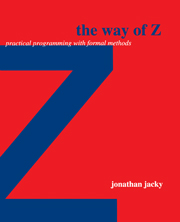Book contents
- Frontmatter
- Contents
- Preface
- I Why Z?
- II Introducing Z
- III Elements of Z
- IV Studies in Z
- V Programming with Z
- 26 Refinement
- 27 Program derivation and formal verification
- 28 From Z to code
- Further reading
- A Glossary of Z notation
- B Omitted features
- C Operator precedence
- D The Z mathematical tool-kit
- E Selected Laws
- F Solutions to selected exercises
- G Other formal notations
- Bibliography
- Index
27 - Program derivation and formal verification
Published online by Cambridge University Press: 06 July 2010
- Frontmatter
- Contents
- Preface
- I Why Z?
- II Introducing Z
- III Elements of Z
- IV Studies in Z
- V Programming with Z
- 26 Refinement
- 27 Program derivation and formal verification
- 28 From Z to code
- Further reading
- A Glossary of Z notation
- B Omitted features
- C Operator precedence
- D The Z mathematical tool-kit
- E Selected Laws
- F Solutions to selected exercises
- G Other formal notations
- Bibliography
- Index
Summary
At last we reach code. This chapter shows how to derive code from formulas taken from a Z specification and demonstrate that the code does what the formulas require. Program derivation is the systematic derivation of code from a formal specification. A proof of correctness demonstrates agreement between code and its specification. Such a proof is a by-product of every program derivation. It is also possible to attempt a formal verification to prove the correctness of an already completed block of code.
Almost all code in use today was produced by traditional informal methods, which are based on adapting code from previously solved problems and making modifications guided by programmers' intuitions about what happens when a computer executes a program. Thinking about what happens in the computer is called operational reasoning (in contrast to formal reasoning, which only considers the program text). Operational reasoning is fallible because it requires programmers to imagine how the values of variables evolve through time as execution takes one path or another through the code. For any but the smallest programs, there are far too many variables, values, and paths to consider, so programmers often resort to running their code to see if it behaves as they intend. This is a trial-and-error process, so it can take a great deal of effort to produce an acceptable product.
Formal program derivation proposes a radical alternative: A program is a formula. It can be derived from a specification, and its properties can be checked by calculation.
- Type
- Chapter
- Information
- The Way of ZPractical Programming with Formal Methods, pp. 254 - 264Publisher: Cambridge University PressPrint publication year: 1996

